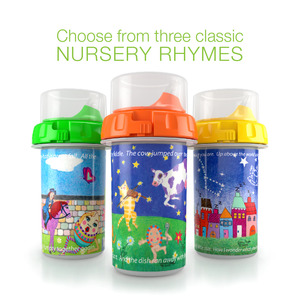***
Poli Sippy Cup Founder Gwen O’Keefe Helps
Parents And Kids Transition To The Sippy Cup
Poli Sippy Cup Founder Gwen O’Keefe Helps
Parents And Kids Transition To The Sippy Cup
Change isn’t easy. Just ask any parent who has been through transitions with their kids. One of the most difficult transitions is from breastfeeding and bottles to sippy cups. Gwen O’Keefe, mom and founder of Poli, home of the easy to clean, non spill Poli Sippy Cup, is here with advice for getting you and your little one through that tough phase and onto something new.
Tips for Transitioning Your Baby to a Sippy Cup
Many new and experienced parents alike are curious as to when the ideal time is to start their baby on a sippy cup or training cup. Some parents start their babies early on and others wait until their baby is moving from bottle/breast at a year. Sippy cups can be a great way for your baby to transition from nursing or bottle-feeding to a regular cup. Using a sippy cup can also improve hand-to-mouth coordination and development of motors skills. Here are a few tips to help you transition your baby to a sippy cup:
- When to Start Transitioning to a
Sippy Cup —
The American Academy of Family Physicians encourages parents to introduce
the sippy cup at six months of age in preparation for weaning from the
bottle or breast at 12 months. Go ahead and try your baby with a sippy at
6 months but keep in mind that they may not be ready for a couple more
months. And just like with any new skill, it takes time, practice, and
patience.
- How to Know When Baby is Ready — The key to baby’s readiness is
the development of a good strong fist grasp and the ability to easily move
things from the hand to the mouth. But keep in mind that using a sippy cup
requires much more than simply picking up an object and putting it into
one’s mouth. It’s a good idea to let baby play with it and get used to it,
not expecting them to fully drink from it for some time. Model the sippy
cup for them so they can see how it’s done and more easily understand the
concept.
- What Sippy Cups Work Best — All babies are different. Some
take to the sippy cup immediately and have no issues with the spout and
valve that prevent spilling while others have a harder time with the
sucking. You may want to invest in a couple types of cups for your baby to
try out. Even consider trying a sippy cup that has a straw.
Important things to look for are sippy cups that are BPA, phthalate and
lead-free, pieces that come apart for easy cleaning (so bacteria and mold
cannot get trapped), a chew-resistant spout, no small parts, and a lid for
travel.
- Do Not Drink and Toddle — Some parents allow their tots
to constantly have a sippy cup within arm’s reach anticipating dire
thirst. However, constant access to a sippy cup containing juice, formula
or breast milk can create a new set of problems from filling up on liquids
to issues with teeth. It’s best to offer the sippy cup throughout the day
rather than allowing constant access. If your baby is very young and not
speaking, teach them the sign language hand motion for “drink” and
practice showing them the sippy cup equals a drink when they’re thirsty.
- What to Put in the Sippy Cup — The best drink to put in your baby’s sippy cup is water. It’s also ok to offer breastmilk/formula, but it’s a great idea to start your baby with water when they’re young. Some parents use this opportunity to offer juice, but if you do opt for juice, make sure it’s watered down considerably (1 part juice to at least 3 parts water). Instead of store bought fruit juice, you can also make your own homemade flavored water using real fruit and water. Pick ripe fruits like peaches, mangos, and blueberries. Try one fruit at a time with the water to confirm your baby doesn’t have an allergic reaction to the fruit. No more than 4 ounces of juice or less per day.
Gwen’s
suggestions are available to share with your audience with the below bio and
link/credit to http://usapoli.com included.
Gwen O’Keefe, founder of Poli, created the Poli Sippy Cup after many frustrations with sippy cups that weren’t easy-to-use or clean and without so many small parts to lose. Using her love of painting and teaching children, she included designs from nursery rhymes to make the sippy cups both fun and educational.
What makes the Poli Sippy Cup ($17.95) different from all the others is it has a valve that comes apart for fast and easy cleaning – and a brush is not needed for cleaning! It’s also dishwasher safe, making cleaning that much easier. The Poli Sippy Cup is also free of nooks and crannies that icky bacteria is notorious for hiding in and turning into mold. These cups are BPA, phthalates and lead free. Aside from the health and safety benefits, parents won’t go crazy over losing parts because every piece is attached – you can’t possibly lose any! Available at http://usapoli.com.
Gwen O’Keefe, founder of Poli, created the Poli Sippy Cup after many frustrations with sippy cups that weren’t easy-to-use or clean and without so many small parts to lose. Using her love of painting and teaching children, she included designs from nursery rhymes to make the sippy cups both fun and educational.
What makes the Poli Sippy Cup ($17.95) different from all the others is it has a valve that comes apart for fast and easy cleaning – and a brush is not needed for cleaning! It’s also dishwasher safe, making cleaning that much easier. The Poli Sippy Cup is also free of nooks and crannies that icky bacteria is notorious for hiding in and turning into mold. These cups are BPA, phthalates and lead free. Aside from the health and safety benefits, parents won’t go crazy over losing parts because every piece is attached – you can’t possibly lose any! Available at http://usapoli.com.




No comments:
Post a Comment
I love comments. Please feel free to leave a comment. I would love to talk to you further